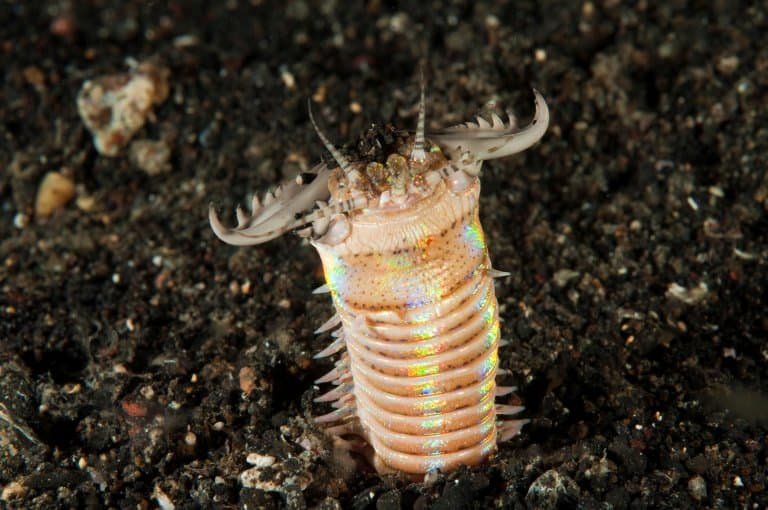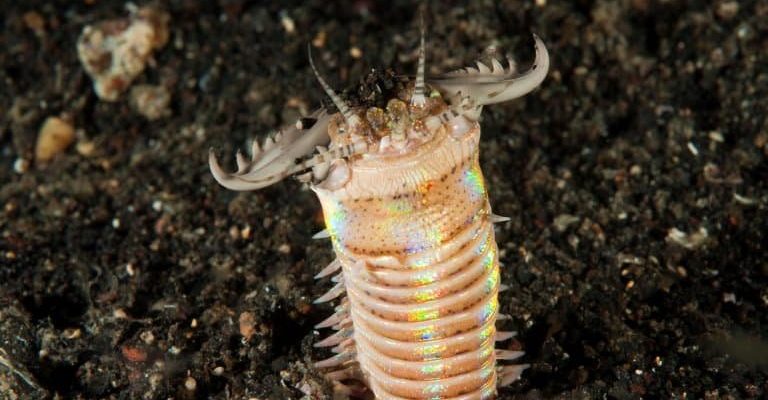
Here’s the thing: while Bobbit worms can be intimidating, especially with their impressive hunting skills, understanding their biology helps demystify them. You might be wondering, do these fascinating creatures pose a real threat to humans? Let’s dive deeper into the murky waters of the Bobbit worm’s world and uncover the truth about their potential toxins and venom.
What Are Bobbit Worms?
Bobbit worms, scientifically known as **Eunice aphroditois**, are marine polychaete worms that can be found in warm waters worldwide. These worms can grow to impressive lengths, sometimes reaching up to 10 feet! They have a unique appearance with a segmented body and a set of antennae that resembles a pair of devil horns waving in the water. Most of their time is spent buried in the sand or mud, with only their heads peeking out, ready to ambush unsuspecting prey.
Their habitat usually includes coral reefs, where they blend seamlessly into their surroundings. This adaptation makes them effective hunters, as they can quickly lash out and grab onto fish or crustaceans drifting by. It’s not just their size or appearance that grabs attention; their predatory skills are what really makes them stand out in the underwater food chain.
Understanding Toxins and Venom
Before we dig into whether Bobbit worms have toxins or venom, let’s break down what these terms mean. **Toxins** are harmful substances produced by living organisms that can cause damage when they enter another organism’s body. On the other hand, **venom** is a specific type of toxin that’s injected through a bite or sting. Think of it like the difference between a poison apple and a bee sting; both are harmful, but they get their effects across in different ways.
When talking about marine creatures like Bobbit worms, understanding these definitions is critical. Often, people confuse toxins with venom, thinking they’re the same. The truth is that while some creatures use venom for hunting or self-defense, others might just have toxins that are harmful if ingested or touched.
So, do Bobbit worms fit into the venom category, or are they the toxin type? Let’s find out!
Do Bobbit Worms Have Venom?
Bobbit worms don’t actually possess venom in the way some other marine creatures do, like jellyfish or cone snails. Instead, they have a **unique hunting mechanism**. When they strike, they use their sharp jaws to grab onto prey. Although their bite can hurt, they don’t inject venom.
It’s important to note that their jaws are equipped with strong, serrated teeth that can easily take down fish and crustaceans. A bite from a Bobbit worm can cause irritation and discomfort, but it’s generally not dangerous to humans. Still, if you ever find yourself in the waters where these creatures live, it’s best to be cautious and respectful of their space.
Do Bobbit Worms Release Toxins?
Now, let’s address the core question: Do Bobbit worms release toxins? The short answer is no, they don’t release toxins in the same way some other sea creatures do. However, their bodies may contain substances that can be harmful if ingested. Just like many other marine organisms, Bobbit worms can pick up harmful materials from their environment, making them less than desirable to eat.
Here’s where it gets a bit more complex. While they don’t actively use toxins to defend themselves, their diet may expose them to toxins found in their prey. This could potentially make them harmful if consumed. But in terms of direct toxicity, their primary defense mechanism isn’t through the release of harmful substances but rather through their ambush-and-grab hunting style.
How Bobbit Worms Hunt
Bobbit worms are masters of stealth and surprise. They spend most of their time hidden, creating a **sand tube** for camouflage. When an unsuspecting fish swims too close, the Bobbit worm strikes with lightning speed. They can extend and retract their bodies quickly, making it look like they’ve suddenly appeared out of nowhere.
Once they grab their prey, they use their powerful jaws to slice through it. The whole process is almost like watching a dramatic underwater thriller. One moment, everything seems calm, and the next, *bam!*—the worm has its meal. This ambush technique demonstrates how effective they are as predators without needing toxins or venom to assist in their hunting.
Potential Risks of Interacting with Bobbit Worms
While Bobbit worms aren’t venomous, it’s still a good idea to avoid direct contact. Their bite can be painful, and given their sharp teeth, it can cause cuts or abrasions. Picture this: you’re wading into shallow waters, and you accidentally disturb one. If it feels threatened, it might bite in defense.
If you’re snorkeling or diving in areas where they inhabit, try to keep your distance. Just because they don’t actively hunt humans doesn’t mean you should poke around looking for them. As with many creatures in the ocean, respect their space and let them thrive in their natural habitat.
Bobbit worms are one of those unique creatures that remind us of the ocean’s mysteries. Even though they’re not venomous and don’t actively release toxins, there’s still a lot to learn about their impressive hunting techniques and behavior. They play a crucial role in the marine ecosystem, helping to keep the balance of life beneath the waves.
So, the next time you hear about Bobbit worms, you can confidently say they’re fascinating, but not quite the dangerous villains some might think. These worms are a reminder of the beauty and complexity of marine life. Let’s keep exploring, learning, and appreciating the wonders of our oceans—one surprising creature at a time!

